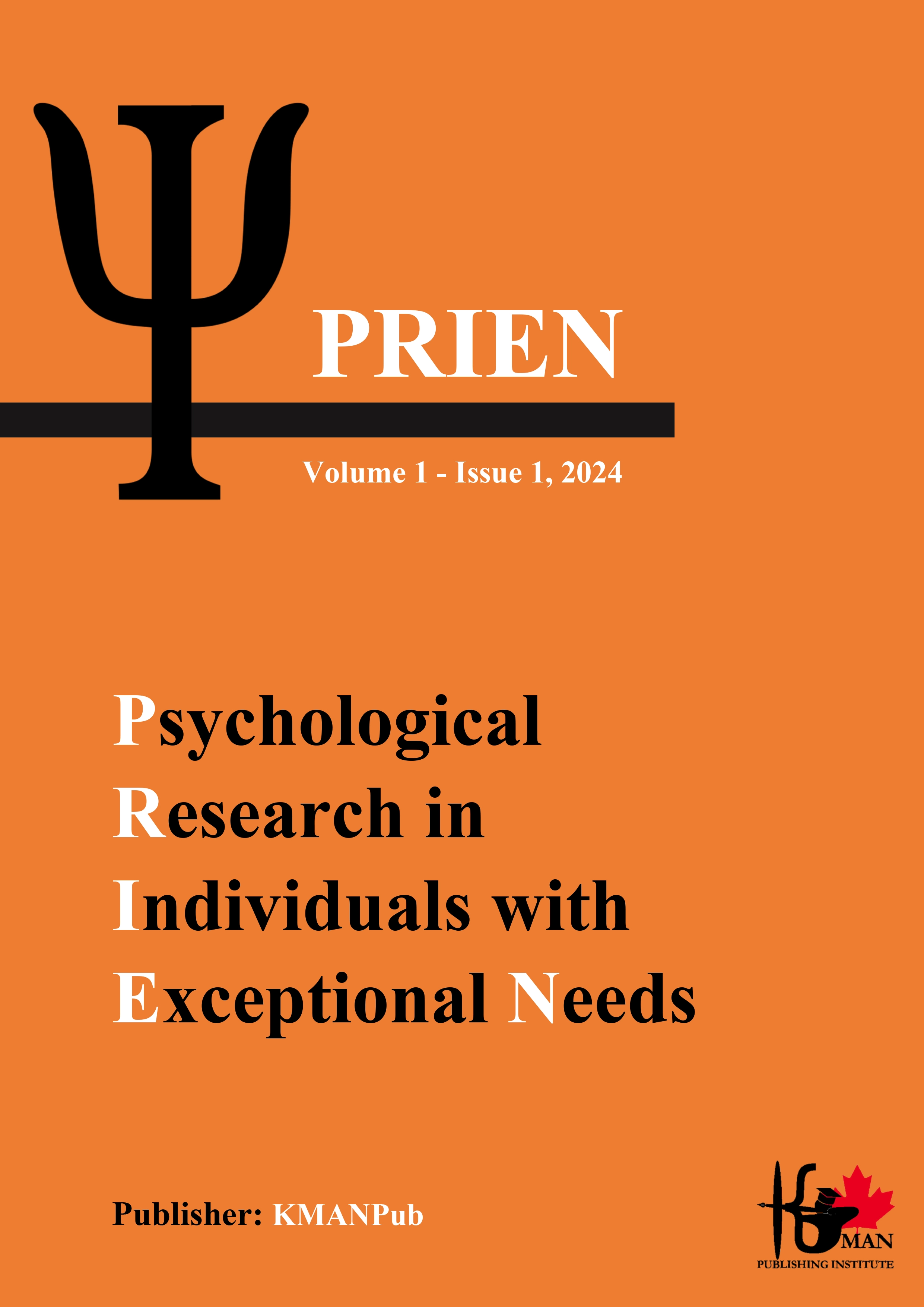Empathy and Adaptive Behavior as Predictors of Neurodevelopmental Functioning in Adolescents with Autism Spectrum Disorder
Keywords:
Autism Spectrum Disorder, Empathy, Adaptive Behavior, Neurodevelopmental Functioning, AdolescentsAbstract
This study aims to investigate the predictive relationship between empathy, adaptive behavior, and neurodevelopmental functioning in adolescents with Autism Spectrum Disorder (ASD). Understanding how these factors interplay can inform targeted interventions to enhance the quality of life and developmental outcomes for this population. The study employed a cross-sectional design with a sample of 330 adolescents diagnosed with ASD, aged 12 to 18 years. Participants were assessed using the Vineland Adaptive Behavior Scales, Third Edition (Vineland-3) for neurodevelopmental functioning, the Interpersonal Reactivity Index (IRI) for empathy, and the Adaptive Behavior Assessment System, Third Edition (ABAS-3) for adaptive behavior. Data analysis included descriptive statistics, Pearson correlation, and linear regression using SPSS-27. Descriptive statistics revealed mean scores of 85.45 (SD = 15.23) for neurodevelopmental functioning, 52.30 (SD = 8.57) for empathy, and 70.12 (SD = 10.34) for adaptive behavior. Pearson correlation analysis showed significant positive correlations between neurodevelopmental functioning and both empathy (r = .56, p < .001) and adaptive behavior (r = .67, p < .001). The regression analysis indicated that empathy (β = .38, p < .001) and adaptive behavior (β = .52, p < .001) significantly predict neurodevelopmental functioning, explaining 55% of the variance (R² = .55, p < .001). The study findings highlight the significant roles of empathy and adaptive behavior in predicting neurodevelopmental functioning in adolescents with ASD. Interventions focusing on enhancing these areas could positively impact the overall development and daily functioning of individuals with ASD. Future research should utilize longitudinal designs to further explore these relationships and examine the effectiveness of targeted interventions.
Downloads
References
Charman, T., Swettenham, J., Baron‐Cohen, S., Cox, A., Baird, G., & Drew, A. (1997). Infants With Autism: An Investigation of Empathy, Pretend Play, Joint Attention, and Imitation. Developmental Psychology, 33(5), 781-789.https://doi.org/10.1037/0012-1649.33.5.781
Clark, S. S., & Giacomantonio, S. G. (2013). Music Preferences and Empathy: Toward Predicting Prosocial Behavior. Psychomusicology Music Mind and Brain, 23(3), 177-186.https://doi.org/10.1037/a0034882
Cristofani, C., Sesso, G., Cristofani, P., Fantozzi, P., Inguaggiato, E., Muratori, P., Narzisi, A., Pfanner, C., Pisano, S., Polidori, L., Ruglioni, L., Valente, E., Masi, G., & Milone, A. (2020). The Role of Executive Functions in the Development of Empathy and Its Association With Externalizing Behaviors in Children With Neurodevelopmental Disorders and Other Psychiatric Comorbidities. Brain Sciences, 10(8), 489.https://doi.org/10.3390/brainsci10080489
Davico, C., Marcotulli, D., Cudia, V. F., Arletti, L., Ghiggia, A., Svevi, B., Faraoni, C., Amianto, F., Ricci, F., & Vitiello, B. (2022). Emotional Dysregulation and Adaptive Functioning in Preschoolers With Autism Spectrum Disorder or Other Neurodevelopmental Disorders. Frontiers in Psychiatry, 13.https://doi.org/10.3389/fpsyt.2022.846146
Duncan, A., & Bishop, S. (2013). Understanding the Gap Between Cognitive Abilities and Daily Living Skills in Adolescents With Autism Spectrum Disorders With Average Intelligence. Autism, 19(1), 64-72.https://doi.org/10.1177/1362361313510068
Feldman, J., Cassidy, M., Liu, Y., Kirby, A. V., Wallace, M. T., & Woynaroski, T. G. (2020). Relations Between Sensory Responsiveness and Features of Autism in Children. Brain Sciences, 10(11), 775.https://doi.org/10.3390/brainsci10110775
Goering, M., & Mrug, S. (2023). The Effects of Parental Nurturance, Harsh Discipline, and Inter-Parental Conflict on Empathy Development in Early Adolescence. The Journal of Early Adolescence, 43(9), 1164-1188.https://doi.org/10.1177/02724316231151997
Graaff, J. V. d., Branje, S., Wied, M. d., & Meeus, W. (2012). The Moderating Role of Empathy in the Association Between Parental Support and Adolescent Aggressive and Delinquent Behavior. Aggressive Behavior, 38(5), 368-377.https://doi.org/10.1002/ab.21435
Johnson, S. A., Filliter, J. H., & Murphy, R. R. (2009). Discrepancies Between Self- And Parent-Perceptions of Autistic Traits and Empathy in High Functioning Children and Adolescents on the Autism Spectrum. Journal of Autism and Developmental Disorders, 39(12), 1706-1714.https://doi.org/10.1007/s10803-009-0809-1
Marotta, R., Risoleo, M. C., Messina, G., Parisi, L., Carotenuto, M., Vetri, L., & Roccella, M. (2020). The Neurochemistry of Autism. Brain Sciences, 10(3). Mesurado, B., Richaud, M. C., Mestre, M. V., García, P. S., TurPorcar, A., Mesa, S. A. M., & Viveros, E. F. (2014). Parental Expectations and Prosocial Behavior of Adolescents From Low-Income Backgrounds. Journal of Cross-Cultural Psychology, 45(9), 1471-1488.https://doi.org/10.1177/0022022114542284
Overgaauw, S., Rieffe, C., Broekhof, E., Crone, E. A., & Güroğlu, B. (2017). Assessing Empathy Across Childhood and Adolescence: Validation of the Empathy Questionnaire for Children and Adolescents (EmQue-CA). Frontiers in psychology, 8.https://doi.org/10.3389/fpsyg.2017.00870
Picci, G., & Scherf, K. S. (2014). A Two-Hit Model of Autism. Clinical Psychological Science, 3(3), 349-371.https://doi.org/10.1177/2167702614540646
Puig, V. (2013). Verbal Memory and IQ Predict Adaptive Behavior in Children and Adolescents With High-Functioning Autism Spectrum Disorders. Journal of Intellectual Disability - Diagnosis and Treatment, 1(1), 22-27.https://doi.org/10.6000/2292-2598.2013.01.01.4
Rueda, P., & Schonert‐Reichl, K. A. (2014). Empathic Abilities and Theory of Mind in Adolescents With Asperger Syndrome: Insights From the Twenty-First Century. Review Journal of Autism and Developmental Disorders, 1(4), 327-343.https://doi.org/10.1007/s40489-014-0026-5
Smith, L. E., Greenberg, J. S., & Mailick, M. R. (2014). The Family Context of Autism Spectrum Disorders. Child and Adolescent Psychiatric Clinics of North America, 23(1), 143-155.https://doi.org/10.1016/j.chc.2013.08.006
Tomaszewski, B., DaWalt, L. S., & Odom, S. L. (2018). Growth Mixture Models of Adaptive Behavior in Adolescents With Autism Spectrum Disorder. Autism, 23(6), 1472-1484.https://doi.org/10.1177/1362361318815645
Vilas, S. P., Reniers, R., & Ludlow, A. (2021). An Investigation of Behavioural and Self-Reported Cognitive Empathy Deficits in Adolescents With Autism Spectrum Disorders and Adolescents With Behavioural Difficulties. Frontiers in Psychiatry, 12.https://doi.org/10.3389/fpsyt.2021.717877
Wallace, G. L., Case, L. K., Harms, M. B., Silvers, J. A., Kenworthy, L., & Martin, A. (2011). Diminished Sensitivity to Sad Facial Expressions in High Functioning Autism Spectrum Disorders Is Associated With Symptomatology and Adaptive Functioning. Journal of Autism and Developmental Disorders, 41(11), 1475-1486.https://doi.org/10.1007/s10803-010-1170-0
Wu, Q. (2023). Empathy and Cooperation Vary With Gender in Chinese Junior High School Adolescents. PsyCh Journal,13(1), 55-65.https://doi.org/10.1002/pchj.705
Xu, Y. (2023). Cognitive Reappraisal and Empathy Chain-Mediate the Association Between Relative Deprivation and Prosocial Behavior in Adolescents. Frontiers in psychology, 14.https://doi.org/10.3389/fpsyg.2023.1238308
Downloads
Additional Files
Published
Issue
Section
License

This work is licensed under a Creative Commons Attribution-NonCommercial 4.0 International License.
















